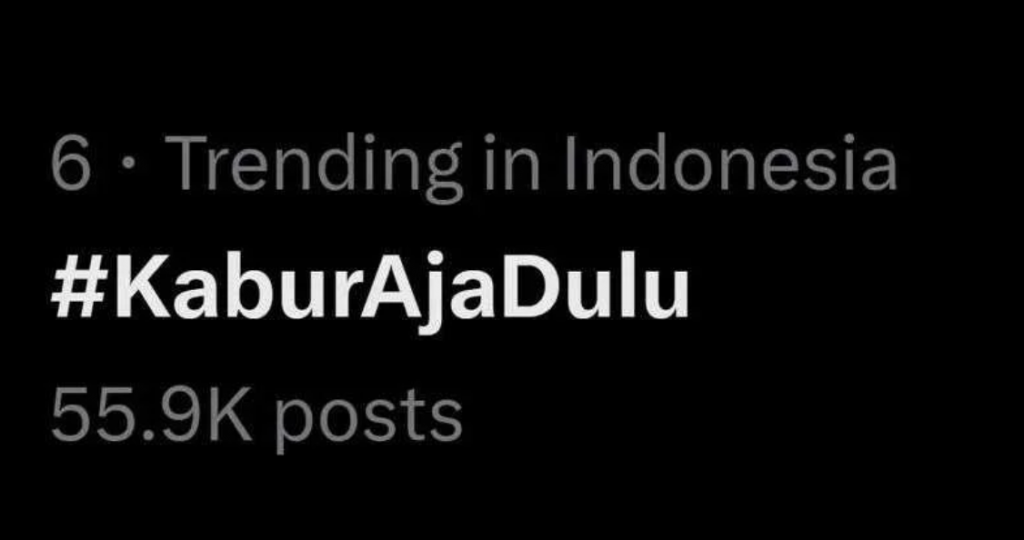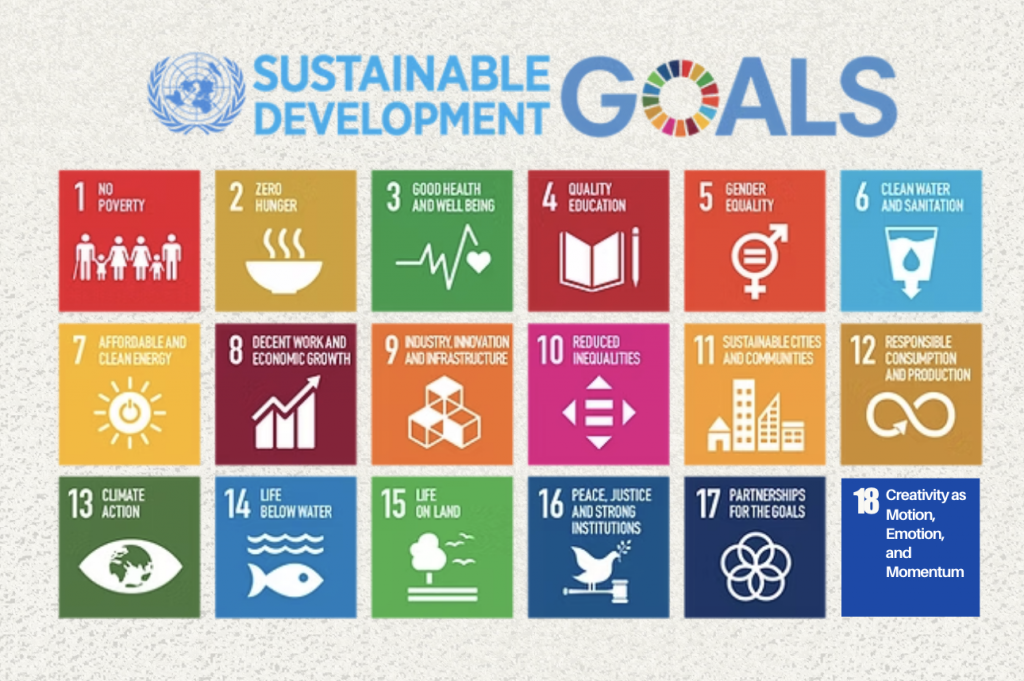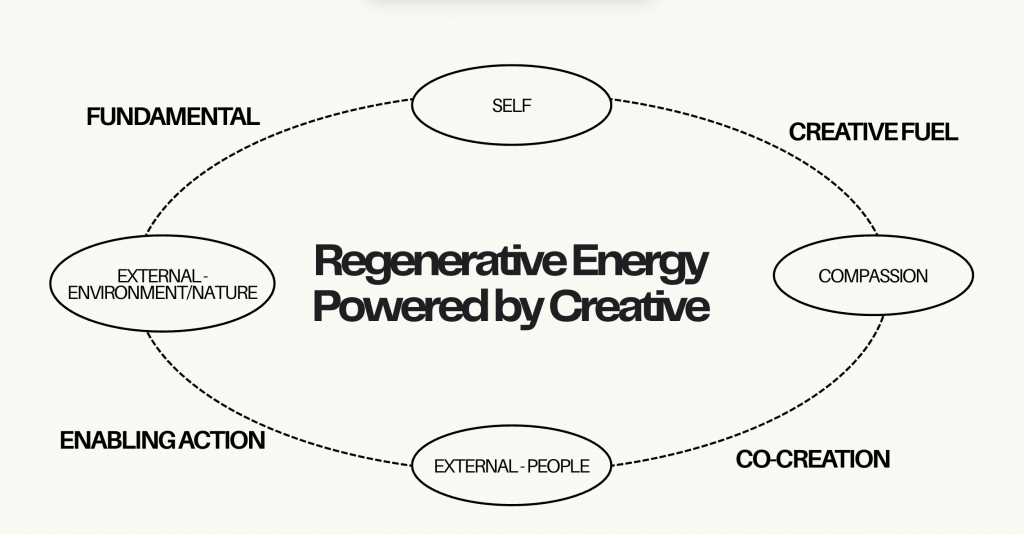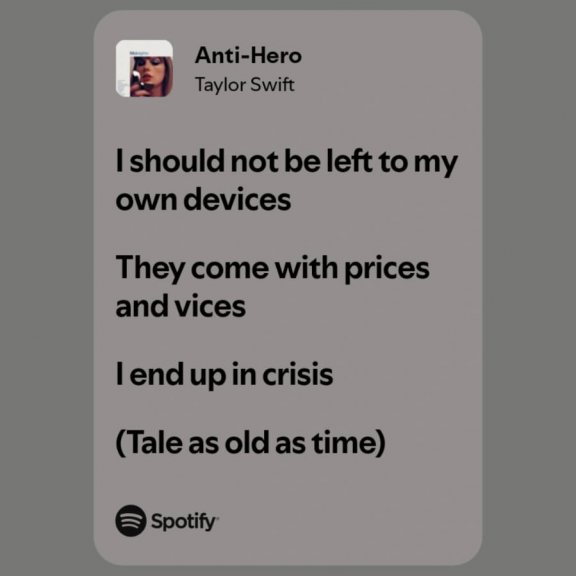What if the future is not only contributed by the tech-bros and the policy makers. What if they are designed by the artists, the designers, the runners, the cyclist and many other creative communities that might have exciting ideas to shaped the world. That’s the change I want to see—a realistic utopia powered by creative communities and creative practitioners to push creative ideas as a new form of renewable energy.
What Is Happening

On my previous writing, I talked about how Indonesians are facing mixed challenges that stirring the movement of #KaburAjaDulu or “Let’s Runaway First” from people in the country. The complex problem from economic challenges, air pollution, excessive extractivism, and social dynamic added up frustration among people, thus, they are powerful evidences of how the system has failed to offer them a promising future. While the idea of leaving Indonesia first and returning only after achieving success may sound appealing, the reality of migrating abroad is far more complex and have various barriers to make people unable to fleet, according to Chatib Basri, Indonesian Economist.
The paradox is, how can people be able to move abroad if the resources and energy are not easy to obtain. Energy, as explained by US Energy Information Administration, means the ability to do work. And by means of ‘do’ in this writing context, is related to willingness and capabilities from the human themselves. Inaccessible opportunities and financial constraints are factors that makes people’s energy non-transferrable, thus, if the fundamentals cannot be obtain, the potentials are not incapable to be properly invested.
An American ecology professor, Charles Hall, explained the central principle of Energy Returned on Energy Invested (EROEI), it takes energy to obtain energy and the energy needed to run the system won’t be available – if it is lacking or no equilateral with the required investment. He also added, ‘You can’t have an economy without energy. Energy does the work!’ The context is similar on reaching your own dreams in particular, it is easier for people who are equipped with sourceful energy – money and opportunities, rather than people who might have so many dreams but lack of source and opportunities.
If dreaming is taking so much energy and privilege for some people, the bigger the dream is, it might be harder for people to reach it. But what if the energy itself is coming from within, people’s motivation and creativity. This idea validated after my interview with Guri, a musician and creator of In.Inertia. She said while acknowledging the common perception that privilege can provide advantages for creative workers in the creative industries, Guri disagrees that it is the sole determinant of success. She emphasizes the importance of good quality work, effective marketing (especially in the digital age), and perseverance, taking on examples of artists who rose to prominence from less privileged backgrounds.
Why creativity as energy?
Creativity, according to Stanford, can refer to a person, a process or activity, or a product—which may include an idea in someone’s mind, an observable performance, or a tangible artifact. Moreover, creativity is a disposition: a combination of ability and motivation to produce something new and valuable. It involves the exercise of choice, evaluation, understanding, and judgment—an expression of agency (Gaut, 2014a: 273).
“The creative industry is the most flexible and resilient industry when it comes to generating innovation,” said Viandira Athia, Co-Founder of the ASEAN Creative Economy Youth Summit (ACE-YS), during our previous interview. Moreover, even during the pandemic, the creative economy managed not just to survive, but to thrive. An Indonesian government‘s report attributes this resilience to three main factors. First, the creative sector’s natural integration with technological advances and the information-rich nature of the digital era. Second, its ecosystem of stakeholders—ready to collaborate, pool resources, and spark new ideas. And third, the ability to adapt and evolve rapidly in response to external challenges.
In 2015 the Sustainable Development Goals charter are made, but apparently many people have doubted the goals are fully achieved on its due in 2030, because the progress has not yet giving so many progress. We must collectively increase our abilities to face and work effectively with complex challenges, and it can be achieved by individual agency and creativity.

And maybe—it’s time to see creativity as the 18th Sustainable Development Goal. When the current SDGs are struggling to solve complex issues, we need to expand the list—because creativity brings in new approaches, community-led innovation, and regenerative potential that traditional frameworks often miss. I wholeheartedly believe that ideas can become a form of energy, perhaps even the cleanest energy known to humanity.

Inspired by progressive framework to strengthen the SDGs goal; Individual Development Goals, I adapt the framework to my idea of creative as energy framework:

The cycle can happen once it is ignited from the inside as creative fuel, building compassion that made people connects with likeminded people. And as they ripple outward, it created collaboration with community or society and eventually will enabling action for the outside world. This regeneration can help building fundamentals that strengthen ourselves. That’s how creativity can become a regenerative energy, through compassion and connectedness.
Proven by the existence of interest-based community like community running in Jakarta. According Rania, Co-Founder of Heirun Running Club, their collective passion in running has elevate into a well-known community that got a lot of endorsed and helped its member financially. The shared energy future, has already arriving!
If the idea is massive, why is the realization can be so low?
In my personal experience, working as a creative is often being overlooked and not being seen as an actual jobs. Therefore, we were not very much being supported enough in the family and we were hardly capable to realized our ideas and dreams in this field. In a national scale, compensation for creativity is a big problem that both the government and the stakeholders are contributing to.
On my discussion with Eris, Founder of Bogor Illustrator Hub (BIH) a local creative community from Bogor in West Java, he validated that the local government bureaucracy is still the biggest elephant in the room that makes creative funding is so hard to obtain. BIH needed to go to the central, which also took ages to claim and might not be directly to be approved in a short time. The government plan in the creative economy is huge and ambitious, yet not a lot of creatives have benefitted it equally.
The rigid low pricing standards that government projects used, not to mention most of it are time-based prices, can be seen almost as creatives are being punished for being efficient and wanting to contribute to the creative economy. Also by not intervening in the industry practice for pricing and pitching, Indonesian creatives are competing to win as the most suffocating people in the room.
This situation contradicts the concept of Flow by Mihaly Csikszentmihalyi—where creativity thrives when skills meet opportunity, supported by focus, clear goals, and immediate feedback. Unfortunately, scattered attention and delayed support break this flow, making it difficult for creative energy to reach its full potential.
To fix this, three key players must step in: the government, businesses, and researchers. As a researcher, I aim to propose initiatives and platforms that give creative communities the space or outlet to channel their creative energy. When creativity is supported properly, it becomes a powerful energy to unlock ideas, drive personal growth, and contribute to wider societal growth.
Maybe People Might Just Need A Little Bit of Push
As Jonathan Haidt stated in The Anxious Generation, spending too much time critically online—disconnected from real-world, physical experiences—can heighten anxiety and emotional distress. So, why not get up, get out, and seize the opportunity? As Taylor Swift wrote on her lyrics:

Believe me, staying indoor, doom scrolling and spending entire day for screen will not only can cause you anxiety, they might harm your brain and body, and apparently to the environment. According to IEA, the emissions generated by watching 30 minutes of Netflix [1.6 kg of CO2] is the same as driving almost 4 miles. So, why do not we just go out and breathe the fresh air.
During the presentation on developing ideas with Joel Gethin Lewis, course leader on the now Vision Pro only Diploma in Apple Development, there is one slide that triggers my ideas: “Demons hates fresh air.” I can second that, because I have been so frustrated to go round and round in my four walled room to think about my project. And to prove that, I casually invited my classmate to get out to a park and get some coffee with me to help me synthesize my ideas and thought.

After going out and disconnect with the virtual reality, I recognized four things:
1. I have more clarity of my work (internal benefit)
2. I feel freshened up after a walking in nature and grabbed a coffee from the local cafe(community benefit)
3. I helped to contribute my idea towards my friend’s work (external benefit)
4. I do not have to charge my phone over and over after I disconnected (environment benefit)
To optimize the experience of combining skills and opportunities, it requires control over what happens in the mind, one can draw upon an almost infinite range of opportunities for enjoyment—for instance, through the use of physical and sensory skills. And as I mentioned in my previous post, coffee is also an energy fuel for creative people to run an idea, to develop the idea, or maybe to contribute to the government. Which somehow related to this Instagram content.
When I did a primary research using Typeform questionnaire, on how might people wanted to do if they have a café, many people said they wanted the get engaged in creative event in their cafe and somewhat interested in cultural exchange.


Consequently, why not making a place or platform to make people willing to establish their flow and creative energy to cultivate more ideas?
So, How Might We…
Well here we are to finally landed on this question, “How might we established creative ideas as renewable energy, and use coffee-talks as catalysts for community-driven innovation, co-creation and regenerative future?”
In regards to this, I plan to create an intervention by inviting people to talk about their ideas over a coffee. Based on my experience on my previous trip on Istanbul, people generate more meaningful conversations, ideas, and maybe actionable ones when they are discussing over the food or over the coffee, and supported by great ambiance or environment. This coffee-talk intervention will make invite people for a coffee, and make them pour up their ideas, and store their ideas into ‘idea bank’ that might be actionable in the future.
The future is actually already arrived. Initiatives like Mother Bank and Neneng Rosdiyana’s community projects in rural areas show how creativity can address complex ecological and economic issues—starting with just one conversation and group support.
If we can cultivate more creative potentials, the dream of making creativity as the new renewable energy might drive us to an actual realistic utopia, where people driving towards a brighter future. So, let’s have a coffee-talk about your idea in Regent’s park soon?
Bibliography
Seven Pillars Institute. (2017). Realistic Utopia. [online] Seven Pillars Institute. Available at: https://sevenpillarsinstitute.org/glossary/realistic-utopia/ [Accessed 19 Apr. 2025].
Inner Development Goals. (n.d.). Inner Development Goals – Inner Growth for Outer Change. Retrieved April 20, 2025, from https://innerdevelopmentgoals.org/
U.S. Energy Information Administration. (2024). What is energy? [online] Available at: https://www.eia.gov/energyexplained/what-is-energy/#:~:text=Energy%20is%20the%20ability%20to,use%20it%20to%20do%20work [Accessed 18 Apr. 2025].
Stanford Encyclopedia of Philosophy. (2023). Creativity. [online] Available at: https://plato.stanford.edu/entries/creativity/ [Accessed 19 Apr. 2025].
Shape of Thoughts. (2021). Problems of the creative industry in Indonesia and how to fix it. [online] Available at: https://www.shapeofthoughts.com/thoughts/problems-of-the-creative-industry-in-indonesia-and-how-to-fix-it [Accessed 19 Apr. 2025].
Indonesia2045.go.id. (n.d.). Indonesia Vision 2045. [online] Available at: https://indonesia2045.go.id/ [Accessed 19 Apr. 2025].
International Energy Agency. (2020). The carbon footprint of streaming video: Fact-checking the headlines. [online] Available at: https://www.iea.org/commentaries/the-carbon-footprint-of-streaming-video-fact-checking-the-headlines [Accessed 19 Apr. 2025].
National Geographic. (2022). Istanbul’s ancient coffee culture is holding its own in the modern world. [online] Available at: https://www.nationalgeographic.com/travel/article/istanbuls-ancient-coffee-culture-holding-own-modern-world [Accessed 19 Apr. 2025].
George and Clark. (n.d.). Mother Bank. [online] Available at: https://www.georgeandclark.com/mother-bank/ [Accessed 19 Apr. 2025].
Kompasiana. (2024). Neneng-isme: Gambaran Kedaulatan Bangsa Rakyat di Tengah Krisis. [online] Available at: https://www.kompasiana.com/restukandela/67ab842eed64155b6502b222/neneng-isme-gambaran-kedaulatan-bangsa-rakyat-di-tengah-krisis [Accessed 19 Apr. 2025].
Medium. (2022). Building a Regenerative Future. [online] Design for Sustainability. Available at: https://designforsustainability.medium.com/building-a-regenerative-future-4b6bf40842b6 [Accessed 19 Apr. 2025].
Instagram. (2025). [Instagram post]. Available at: https://www.instagram.com/p/DGgmXQLp8Sr/?hl=en [Accessed 19 Apr. 2025].
Wirjawan, G. (2023). Realistic Utopia: A Conversation with Gita Wirjawan [YouTube video]. Available at: https://www.youtube.com/watch?v=Xi6USMoORB0 [Accessed 19 Apr. 2025].
Thackara, J. (2016). How to thrive in the next economy: Designing tomorrow’s world today. London: Thames & Hudson.
Csikszentmihalyi, M. (2008). Flow: The Psychology of Optimal Experience. New York: Harper Perennial.
Bregman, R. (2020). Humankind: A Hopeful History. London: Bloomsbury Publishing.
Landry, C. (2008). The Creative City: A Toolkit for Urban Innovators. London: Earthscan.
Austin, T. (2016). Narrative Environments and Experience Design: Space as a Medium of Communication. London: Routledge
Demeiati, NK. Dion, MP. Novin, W (2024). Unveiling Creative Economy Resilience in Indonesia amidst the Global Pandemic. [online] Available at: https://doi.org/10.1163/27730611-bja10022 [Accessed 19 Apr. 2025].
My Previous Blog & Miro for My Chain of Thoughts
- https://sashasafarina.myblog.arts.ac.uk/2025/03/21/what-is-the-change-i-want-to-see-a-discovery-part-1/
- https://sashasafarina.myblog.arts.ac.uk/2025/04/06/what-is-the-change-i-want-to-see-a-discovery-part-2/
- https://sashasafarina.myblog.arts.ac.uk/2025/04/09/a-story-from-turk-kahvesi/
- https://sashasafarina.myblog.arts.ac.uk/2025/04/11/i-asked-chatpt-about-brighton-alternatives/
- https://miro.com/app/board/uXjVIPS9rGA=/?share_link_id=790426926739
Leave a Reply